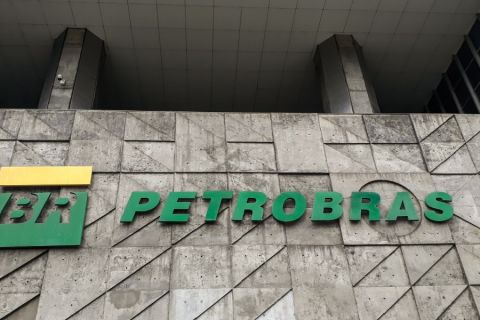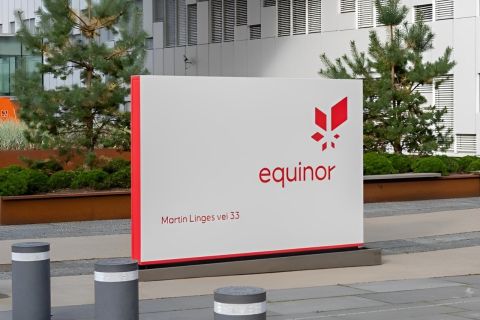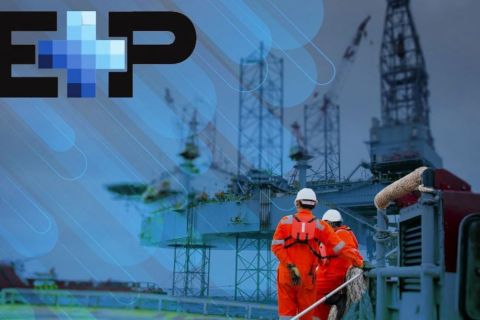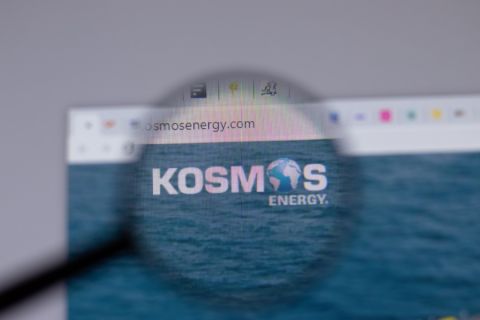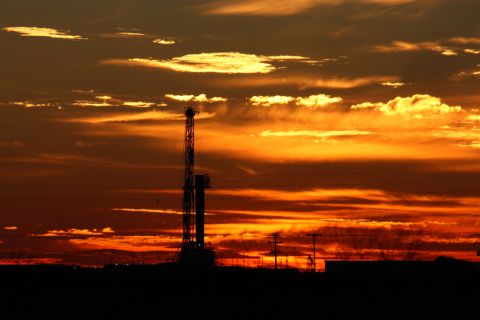Shell Exploration & Production will break new ground as it reaches for production from the deepest-water wells in the world at its Perdido regional development near the southern boundary of the US side of the Gulf of Mexico.
It will be one of the first companies to produce from the prolific Lower Tertiary trend, which
 |
|
| The topsides unit for Perdido contains a full drilling rig, oil and gas processing equipment, and operations and living quarters, all capable of being mounted on the spar hull in a single lift. (All graphics courtesy of Shell Exploration & Production) |
Records fall frequently for the company. A decade ago it claimed the world water depth production record at 5,300 ft (1,616 m) with its Mensa subsea field in Mississippi Canyon 731.
It built the Na Kika long-ranging production system centered on a semisubmersible production hub. The field in the deepest water on that system is Shell’s Coulomb in 7,558 ft (2,305 m) of water in Mississippi Canyon 613 and 657. It started production in 2003.
Anadarko Petroleum Corp. is installing its Independence Hub semisubmersible production center in 8,000 ft (2,440 m) of water with production from several deepwater wells. The deepest well will be Cheyenne in 8,938 ft (2,740 m) of water in Lloyd Ridge 399. It’s Anadarko’s well now, but Shell drilled the discovery.
Now Shell is moving forward with the Perdido Development host platform, seeking regulatory approvals and aiming at new records along the way. That doesn’t mean the company will gamble on untried technology.
“All the technologies have elements used in other places. We’re putting ideas together in different ways,” said Dale Snyder, project manager with Shell for its Great White field and the Perdido project.
Challenges
In this project, those elements will have to work a little harder, and the reservoir properties dictate a different approach to construction.
Take a look at the challenges. The Perdido hub in Alaminos Canyon 857 will claim the title for production from the deepest water through a spar platform as it’s moored in about 8,000 ft of water. That’s about 2,600 ft (793 m) deeper water than the current record for a spar platform.
It will produce from three fields. Great White is the flagship field, covering more than six blocks in water depths from 7,500 to 9,500 ft (2,288 to 2,898 m). Those blocks are Alaminos Canyon 812, 813, 814, 857, 900 and 901. Although Shell hasn’t released reserve figures, IHS Inc. estimated reserves at 500 million boe not long after the discovery. About 80% of the initial 130,000 boe/d of production will come from the three producing zones in Great White, Snyder said. The deepest of the five wells drilled to date reached a true vertical depth of 15,035 ft (4,586 m).
Additional recovery will come from Silvertip in Alaminos Canyon 815 in about 9,200 ft (2,806 m) immediately east of Great White. The discovery well in that field is 14,778 ft (4,507 m) deep.
Tobago, the third field tied back to the hub, will be another record-setter. It lies in
 |
|
| The Peridido development project lies at the southern limits of the western US Gulf of Mexico some 60 miles from the nearest operating platform. |
Great White is a challenging reservoir, Snyder said. It needed the operating range of a full-capability drilling rig on the spar for intervention and field adjustments. That rig was critical to the future operations of the field.
The drilling rig also dictated a platform with heave stability, and that was one of the factors that led to the choice of the spar for production, he added. The company looked at a cell spar for the project, but it chose a truss spar because the project needed the higher payload. The cell spar wouldn’t handle the drilling operations and deck load requirements to work with the volume of oil, gas and water expected from the fields.
Putting together a project of this magnitude calls for considerably more research and consideration than a cookie-cutter platform with off-the-shelf technology. Nearly all of the elements of the operation represent a balancing of reliability and risk, Snyder said. The company must be sure that the delivered equipment and systems perform as they were designed.
“We spent a lot of time looking at what others have done to take advantage of available technology,” he said. At those depths and pressures and temperatures, everything an operator does takes technology, know-how and fresh thinking, he added.
At some point later in the life of the field, Shell, the operator with a 35% stake; Chevron, with 37.5%; and BP, with a 27.5% share; may decide to add production from other nearby discoveries, including Trident field, which contains the world’s deepest-water well capable of economic production in nearly 10,000 ft (3,050 m) of water. In addition, Shell’s Hammerhead discovery, is in Alaminos Canyon 943 some 7 miles (11 km) southwest of the western edge of Great White, and Chevron’s Tiger in Alaminos Canyon 818, about the same distance east of Silvertip, are in position to produce through Perdido, but Shell has not announced any intentions about those fields.
Subsea cluster
Production from all three fields will tie back to a central separation and boosting cluster
 |
|
| The subsea separation caissons with their ESPs make up for the relatively low mud-line pressure of the produce oil and gas. |
Production arrives at the central cluster at about 750 psi of pressure, where it faces a riser-head pressure from 8,000 ft of fluid. The system needs artificial lift at that point to reduce back-pressure on the wells by approximately 2,000 psi and move the fluid to the surface.
This combination set the stage for the world’s first host-scale subsea separation and boosting complex and the first application of wet-tree production with direct vertical access to the spar platform.
Production from the three fields is commingled in 300-ft (92-m) caissons. The path of the production stream into the caisson produces a cyclonic separation, Snyder said. Gravity also helps separate the gas from the fluids at the sea floor.
The gas flows through one line to the surface facilities. Five electric-submersible-pump (ESP) booster stations from Centrilift move the oil-water mix that remains up the production risers to the platform for treatment.
The high flow capacity of the ESPs also helps prevent the formation of hydrates.
In case replacement is needed, the ESPs can be easily traded out with any vessel of opportunity, even though the Perdido platform has its own rig.
As with all new Shell projects, Perdido will have smart-field elements built into the operations. The platform will have all the latest monitoring and control equipment, Snyder said, and experts onshore can monitor platform activities and provide advice if it’s needed.
Subsea trees
A typical deepwater system in the Gulf of Mexico brings production from fields to dry trees on production platform decks, Snyder said. Instead, Shell chose to go to wet trees on the ocean floor.
The company wanted to keep the spar platform as small as possible. In addition, the complexity of the reservoir required a lot of wells, more wellheads than the spar could easily handle, he said. The wet trees that aren’t directly under the spar are tied into the subsea separation and booster stations.
Shell awarded the contract to Technip subsidiary Duco for umbilicals to tie the undersea complex together, but that’s not an automatic deal. Duco will build a prototype of the umbilicals for qualification testing at the company’s operation in Newcastle, UK. The contract plans four dynamic umbilicals, three static umbilicals and two flying leads, or flexible connectors, with all of the connections for subsea and platform hookups. The total length of umbilicals is 181,928 ft (53,466 m).
The rig on the spar platform can drill, complete and work over the wells directly beneath the platform, and those wells produce from the most prolific field in the group. The system also uses surface blowout preventers.
Platform
Technip also got the contract to build the spar hull in Pori, Finland.
The contract for the topsides went to the Alliance Engineering subsidiary of Wood Group. That company has a reputation for building deepwater, lightweight topsides units that heavy-lift vessels can place on a platform in 8,000 ft of water in a single lift. That would allow a topsides unit of up to 6,500 tons.
“If you look at the topsides in terms of capability, it’s like Hoover, Atlantis and Holstein,” Snyder said. But this unit will be placed on the hull in a single lift, where other systems often require multiple lifts for modules with the same capability.
The weight is significantly lower than the multiple-lift units. That helps keep costs down, and it allows the company to handle the job with a smaller spar.
As a bonus, the heavy lift vessel doesn’t spend as much time at the site — a considerable savings — and a single lift is safer than multiple lifts. The depth of the spar hull won’t allow a quay-side lift that semisubmersible units can use.
The topsides unit must allow working room for a full-capability drilling rig that can drill to 19,000 ft (5,795 m) or more, and it must have storage room for drill pipe, casing, tubing and a mud system.
Somewhere, the platform must also provide room for the surface blowout preventer; no small piece of equipment.
The platform also will have a full range of equipment. It must process and dry the natural gas that comes from the seafloor separator, and it must supply enough compression to move that gas through the pipeline.
Under the operating plan, natural gas will move by pipeline some 100 miles (160 km) to the north to Anadarko’s Nansen/Boomvang complex, where pipelines will relay it to Texas.
The platform also must apply additional separation to make the oil pipeline-ready, and it must offer enough pumping power to move the oil to the next stop.
Shell will pipe the oil about 60 miles (96 km) to the north to ExxonMobil’s Hoover/Diana complex, also for relay to the Texas coast. There are no relay stations between Great White and Hoover/Diana.
Safety
From the operations design to the single-lift technique to the construction work, safety is a big part of the Perdido package. That includes the work on the hull, umbilicals and subsea trees, separation units, and booster pumps.
“This will be the safest facility we ever put in the Gulf of Mexico,” Snyder said. Perdido is 60 miles from Hoover/Diana, the nearest working facility, and more than 100 miles from the Texas coast. With those distances in mind and the time it takes to make a trip, safety is an important issue.
People at Shell call the platform’s helicopter deck Perdido International, he said, because it’s big enough to handle two of the largest helicopters in operation. At that distance, if something happens to one helicopter, another helicopter would have to land on the platform to bring repair parts and mechanics.
The platform also will carry the largest, fastest rescue craft in the Gulf of Mexico. In an emergency situation, those boats will have to move a lot of crew members a long distance in a hurry.
The goal for the construction project is zero injuries, lost-time incidents and reportable incidents, Snyder added. That also will be a goal on the working platform, but that kind of record requires more than daily safety lectures.
Shell is working with its contractors on the human factors, directing efforts at developing safety attitudes and a safety culture. The companies already are seeing results in the human activity connected with the project.
“We want safety in design, but also in execution,” he added.
Nearly all companies have strong safety programs and, for many of them, safety plateaus at a fairly low incident rate, Snyder said. Reaching the zero point means building awareness of safety into human attitudes.
If all goes according to plan, Shell will have the new hub up and operating at the turn of the decade with innovative technology in place and operating smoothly on a facility that was built with no harmful or reportable incidents.
Recommended Reading
Petrobras Sending Nearly Half of Oil Exports to China
2024-04-30 - Conflict in the Middle East has enabled Brazil’s state-owned Petrobras to change the flow of its oil exports, with China being the primary beneficiary, followed by Europe.
Equinor Says EQT Asset Swap Upgrades International Portfolio
2024-04-30 - Equinor CFO Torgrim Reitan says the company’s recent U.S. asset swap with EQT Corp. was an example of the European company “high-grading” its international E&P portfolio.
E&P Highlights: April 29, 2024
2024-04-29 - Here’s a roundup of the latest E&P headlines, including a new contract award and drilling technology.
Kosmos Energy’s RBL Increased, Maturity Date Extended
2024-04-29 - Kosmos Energy’s reserve-based lending facility’s size has been increased by about 8% to $1.35 billion from $1.25 billion, with current commitments of approximately $1.2 billion.
Barnett & Beyond: Marathon, Oxy, Peers Testing Deeper Permian Zones
2024-04-29 - Marathon Oil, Occidental, Continental Resources and others are reaching under the Permian’s popular benches for new drilling locations. Analysts think there are areas of the basin where the Permian’s deeper zones can compete for capital.

